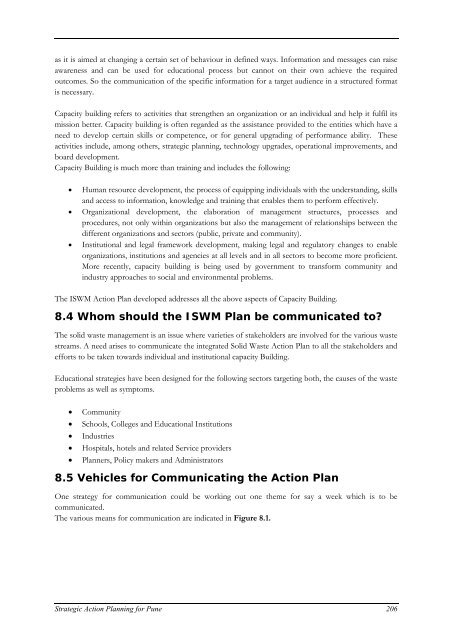Strategic Action Plan - International Environmental Technology Centre
Strategic Action Plan - International Environmental Technology Centre
Strategic Action Plan - International Environmental Technology Centre
Create successful ePaper yourself
Turn your PDF publications into a flip-book with our unique Google optimized e-Paper software.
as it is aimed at changing a certain set of behaviour in defined ways. Information and messages can raise<br />
awareness and can be used for educational process but cannot on their own achieve the required<br />
outcomes. So the communication of the specific information for a target audience in a structured format<br />
is necessary.<br />
Capacity building refers to activities that strengthen an organization or an individual and help it fulfil its<br />
mission better. Capacity building is often regarded as the assistance provided to the entities which have a<br />
need to develop certain skills or competence, or for general upgrading of performance ability. These<br />
activities include, among others, strategic planning, technology upgrades, operational improvements, and<br />
board development.<br />
Capacity Building is much more than training and includes the following:<br />
• Human resource development, the process of equipping individuals with the understanding, skills<br />
and access to information, knowledge and training that enables them to perform effectively.<br />
• Organizational development, the elaboration of management structures, processes and<br />
procedures, not only within organizations but also the management of relationships between the<br />
different organizations and sectors (public, private and community).<br />
• Institutional and legal framework development, making legal and regulatory changes to enable<br />
organizations, institutions and agencies at all levels and in all sectors to become more proficient.<br />
More recently, capacity building is being used by government to transform community and<br />
industry approaches to social and environmental problems.<br />
The ISWM <strong>Action</strong> <strong>Plan</strong> developed addresses all the above aspects of Capacity Building.<br />
8.4 Whom should the ISWM <strong>Plan</strong> be communicated to?<br />
The solid waste management is an issue where varieties of stakeholders are involved for the various waste<br />
streams. A need arises to communicate the integrated Solid Waste <strong>Action</strong> <strong>Plan</strong> to all the stakeholders and<br />
efforts to be taken towards individual and institutional capacity Building.<br />
Educational strategies have been designed for the following sectors targeting both, the causes of the waste<br />
problems as well as symptoms.<br />
• Community<br />
• Schools, Colleges and Educational Institutions<br />
• Industries<br />
• Hospitals, hotels and related Service providers<br />
• <strong>Plan</strong>ners, Policy makers and Administrators<br />
8.5 Vehicles for Communicating the <strong>Action</strong> <strong>Plan</strong><br />
One strategy for communication could be working out one theme for say a week which is to be<br />
communicated.<br />
The various means for communication are indicated in Figure 8.1.<br />
<strong>Strategic</strong> <strong>Action</strong> <strong>Plan</strong>ning for Pune 206
















